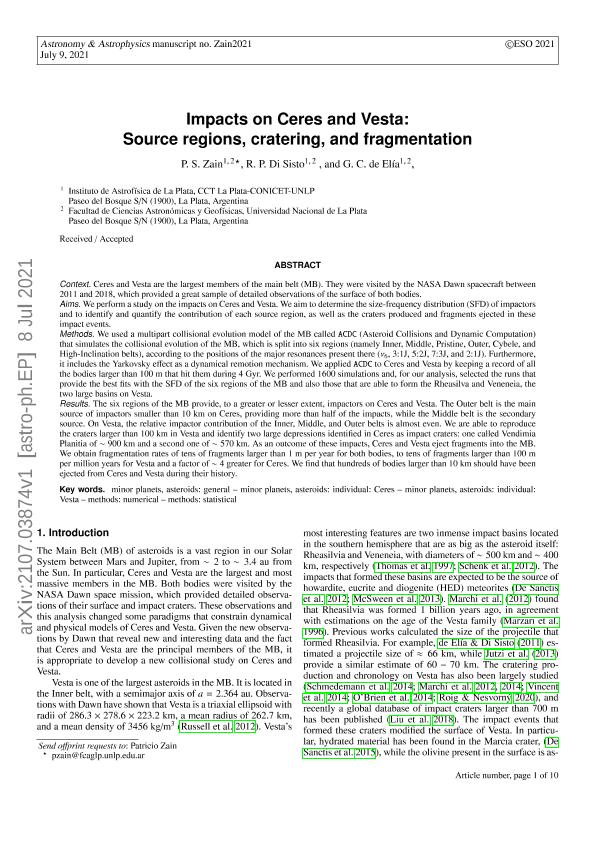Artículo
Impacts on Ceres and Vesta : source regions, cratering, and fragmentation
Fecha de publicación:
08/2021
Editorial:
EDP Sciences
Revista:
Astronomy and Astrophysics
ISSN:
0004-6361
Idioma:
Inglés
Tipo de recurso:
Artículo publicado
Clasificación temática:
Resumen
Context. Ceres and Vesta are the largest members of the main belt (MB). They were visited by the NASA Dawn spacecraft between 2011 and 2018, which provided a great sample of detailed observations of the surface of both bodies.Aims. We perform a study on the impacts on Ceres and Vesta. We aim to determine the size-frequency distribution (SFD) of impactors and to identify and quantify the contribution of each source region, as well as the craters produced and fragments ejected in these impact events.Methods. We used a multipart collisional evolution model of the MB called ACDC (Asteroid Collisions and Dynamic Computation) that simulates the collisional evolution of the MB, which is split into six regions (namely Inner, Middle, Pristine, Outer, Cybele, and High-Inclination belts), according to the positions of the major resonances present there (ν6, 3:1J, 5:2J, 7:3J, and 2:1J). Furthermore, it includes the Yarkovsky effect as a dynamical remotion mechanism. We applied ACDC to Ceres and Vesta by keeping a record of all the bodies larger than 100 m that hit them during 4 Gyr. We performed 1600 simulations and, for our analysis, selected the runs that provide the best fits with the SFD of the six regions of the MB and also those that are able to form the Rheasilva and Veneneia, the two large basins on Vesta.Results. The six regions of the MB provide, to a greater or lesser extent, impactors on Ceres and Vesta. The Outer belt is the main source of impactors smaller than 10 km on Ceres, providing more than half of the impacts, while the Middle belt is the secondary source. On Vesta, the relative impactor contribution of the Inner, Middle, and Outer belts is almost even. We are able to reproduce the craters larger than 100 km in Vesta and identify two large depressions identified in Ceres as impact craters: one called Vendimia Planitia of ~900 km and a second one of ~570 km. As an outcome of these impacts, Ceres and Vesta eject fragments into the MB. We obtain fragmentation rates of tens of fragments larger than 1 m per year for both bodies, to tens of fragments larger than 100 m per million years for Vesta and a factor of ~4 greater for Ceres. We find that hundreds of bodies larger than 10 km should have been ejected from Ceres and Vesta during their history.
Palabras clave:
ASTEROIDS
,
CERES
,
VESTA
,
NUMERICAL
Archivos asociados
Licencia
Identificadores
Colecciones
Articulos(IALP)
Articulos de INST.DE ASTROFISICA LA PLATA
Articulos de INST.DE ASTROFISICA LA PLATA
Citación
Zain, Patricio Salvador; Di Sisto, Romina Paula; de Elía, Gonzalo C.; Impacts on Ceres and Vesta : source regions, cratering, and fragmentation; EDP Sciences; Astronomy and Astrophysics; 652; A122; 8-2021; 1-10
Compartir
Altmétricas




